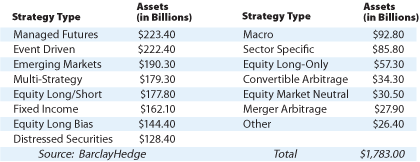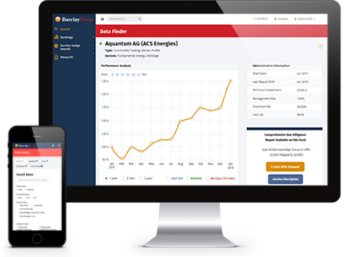Rise in Managed Futures Assets Reflects Growing Investor Preference for Transparency, Liquidity and Lower Volatility
FAIRFIELD, IA – October 5, 2010 – BarclayHedge, Ltd., one of the oldest and most respected global providers of alternative investment data and services, today announced that managed futures has, for the first time since BarclayHedge began tracking hedge fund performance data in 1985, surpassed all other investment strategies, based on assets under management. At the end of the 2nd Quarter 2010, managed futures accounted for $223.4 billion of the total $1.78 trillion invested in all types of hedge fund strategies; followed by Event-Driven strategies ($222.4) and Emerging Markets strategies ($190.3 billion). [See chart below.]
According to Sol Waksman, founder and President of BarclayHedge, “In recent periods of prolonged stock market decline, managed futures have performed well. In 2008, for example, the negative correlation between equities and managed futures was dramatic: the S&P 500 dropped 37% while the Barclay CTA Index – which measures managed futures performance – improved nearly 15%. However, the current growth in managed futures assets has been largely unrelated to stock market correlation or to recent commodity prices, and has been more closely aligned with changing sentiment among sophisticated investors, who are now seeking transparency, liquidity and lower downside volatility within their portfolios.”
Waksman believes the recent growth in managed futures assets is directly related to the underlying characteristics of the asset class, which match up well with current investor sentiment. Waksman notes that futures are exchange-traded, with total transparency and positions marked-to-market daily. Further, even the largest fund managers can readily liquidate their holdings, which means Managed Futures Top Hedge Fund Rankings / Add One investors are not restricted from immediate redemptions. In terms of downside volatility, the Barclay CTA Index’s worst peak-to-valley decline since 1980 was 15.66%, compared with 50.95% for the S&P 500, 49.30% for the Dow Jones Industrials, and 67.65% for the S&P GSCI Commodity Index during that same time period.
“In 2008, investors used managed futures accounts like an ATM machine, taking redemptions that totaled more than $35 billion to meet their liquidity demands. That lesson in the value of liquidity has not been forgotten as investors are now, in 2010, putting assets back into managed futures funds, despite the recent lackluster performance of most Commodity Trading Advisors. In the current flight to safety, and as the asset flow suggests, many investors are including managed futures as part of their core strategy,” Waksman said.

Sol Waksman is an experienced media source, providing perspectives on hedge fund and managed futures trends. For more commentary or background, call 641-472-3456 or email swaksman@barclayhedge.com.
BarclayHedge was founded in 1985 and actively tracks more than 5,700 hedge funds, funds of hedge funds, and managed futures programs. Each month Barclay provides updated performance rankings for 38 Hedge Fund categories and 16 CTA categories.
Institutional investors, brokerage firms and private banks worldwide utilize Barclay’s data as performance benchmarks for the hedge fund and managed futures industries.


